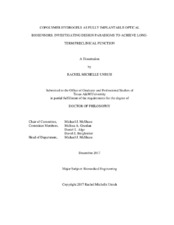| dc.description.abstract | Many diagnostic tests for disease management and overall health monitoring provide only an instantaneous measurement of the patient’s state of health, leaving intermediate fluctuations in biochemistry levels undisclosed. Often, fluid samples are collected periodically and analyzed using ex vivo assays. Diabetes is a prime example of this enigma where knowledge of blood biochemistry fluctuation patterns in real time could allow patients to make more informed treatment and lifestyle decisions.
In recent years, hydrogels have been investigated as fully implantable biosensors by functionalizing them with enzymes and long-lifetime phosphors. However, maintaining a proper balance between enzyme stability and substrate transport when implanted has prevented preclinical proof of concept using this enzyme/phosphor sensing platform. This work explores the effect of matrix chemistry on enzyme stability and substrate transport and demonstrates the first noninvasive glucose tracking in porcine models by measuring luminescence lifetime instead of intensity.
The first aim of this work focuses on poly(HEMA-co-AAm) matrices, characterizing them as glucose sensors in vitro and in vivo. A copolymer hydrogel containing 75:25 HEMA:AAm responded to up to 167 mg/dL of glucose in vitro and tracked real-time porcine blood glucose levels two hours after implantation, the first-reported real-time glucose tracking measuring phosphorescence lifetime using a noninvasive interrogation method. The second aim of this work employs alternative monomers such as dimethylacrylamide, N-vinyl pyrrolidone, and a 3- [Tris(trimethylsiloxy)silyl]propyl methacrylate to investigate enzyme stability and optimize substrate transport. These studies revealed that gels containing dimethylacrylamide and N-vinyl pyrrolidone provide the most enzyme stability, preserving between 60 and 93% of the original apparent activity after one week of incubation, but matrix inhomogeneities from adding silicone monomers can decrease sensor dynamic range by 56%. Finally, hybrid inorganic-organic interpenetrating network hydrogels were developed to prevent silicone phase separation in the hydrogels. These materials increased oxygen transport by up to 256% in vitro compared to pHEMA-based oxygen sensors and responded to modulated inspired oxygen in porcine models over 72 days. Hybrid sensors made with tissue-integrating inverted colloidal crystal architectures revealed minimal fibrosis in vivo with loosely woven collagen surrounding the implants, demonstrating promise for these hybrid materials as long-term implantable biosensors. | en |


